同位语从句语法专题讲解
- 格式:doc
- 大小:566.00 KB
- 文档页数:5
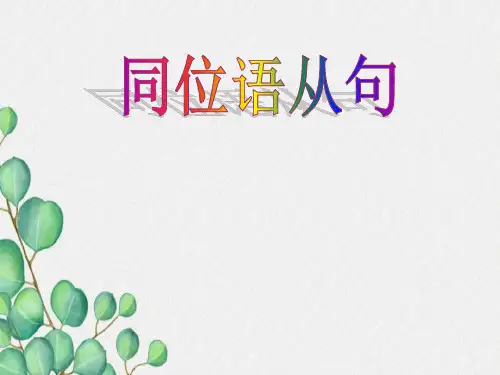
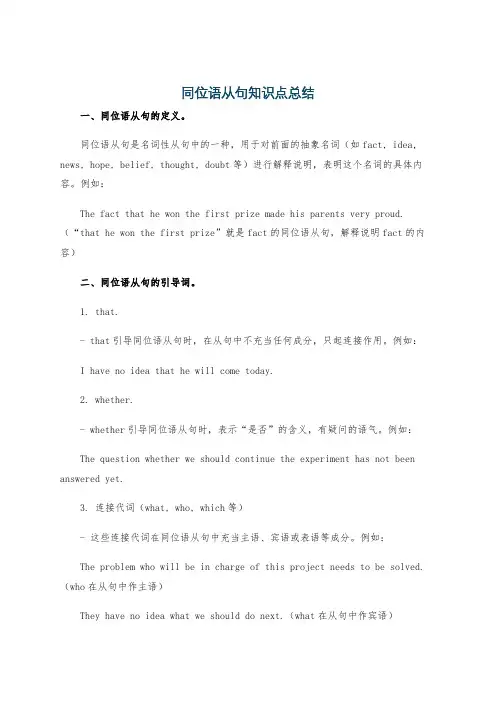
同位语从句知识点总结一、同位语从句的定义。
同位语从句是名词性从句中的一种,用于对前面的抽象名词(如fact, idea, news, hope, belief, thought, doubt等)进行解释说明,表明这个名词的具体内容。
例如:The fact that he won the first prize made his parents very proud.(“that he won the first prize”就是fact的同位语从句,解释说明fact的内容)二、同位语从句的引导词。
1. that.- that引导同位语从句时,在从句中不充当任何成分,只起连接作用。
例如:I have no idea that he will come today.2. whether.- whether引导同位语从句时,表示“是否”的含义,有疑问的语气。
例如:The question whether we should continue the experiment has not been answered yet.3. 连接代词(what, who, which等)- 这些连接代词在同位语从句中充当主语、宾语或表语等成分。
例如:The problem who will be in charge of this project needs to be solved.(who在从句中作主语)They have no idea what we should do next.(what在从句中作宾语)4. 连接副词(when, where, why, how等)- 连接副词在同位语从句中充当状语。
例如:We have no idea when he will come back.(when在从句中作时间状语)The question why he was late has not been answered.(why在从句中作原因状语)三、同位语从句与定语从句的区别。
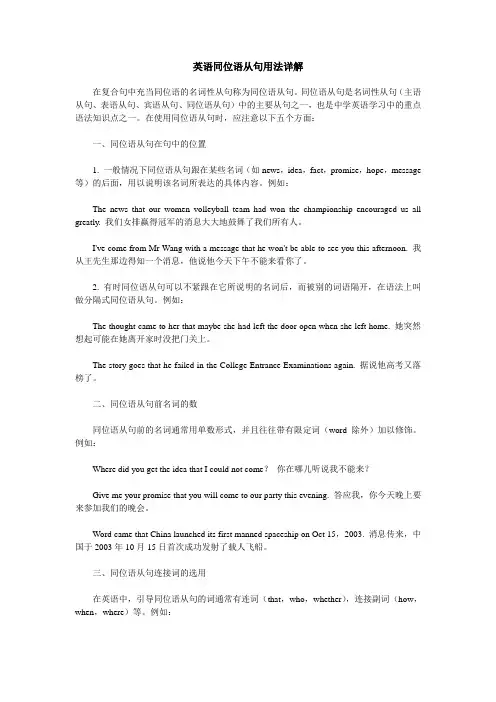
英语同位语从句用法详解在复合句中充当同位语的名词性从句称为同位语从句。
同位语从句是名词性从句(主语从句、表语从句、宾语从句、同位语从句)中的主要从句之一,也是中学英语学习中的重点语法知识点之一。
在使用同位语从句时,应注意以下五个方面:一、同位语从句在句中的位置1. 一般情况下同位语从句跟在某些名词(如news,idea,fact,promise,hope,message 等)的后面,用以说明该名词所表达的具体内容。
例如:The news that our women volleyball team had won the championship encouraged us all greatly. 我们女排赢得冠军的消息大大地鼓舞了我们所有人。
I've come from Mr Wang with a message that he won't be able to see you this afternoon. 我从王先生那边得知一个消息,他说他今天下午不能来看你了。
2. 有时同位语从句可以不紧跟在它所说明的名词后,而被别的词语隔开,在语法上叫做分隔式同位语从句。
例如:The thought came to her that maybe she had left the door open when she left home. 她突然想起可能在她离开家时没把门关上。
The story goes that he failed in the College Entrance Examinations again. 据说他高考又落榜了。
二、同位语从句前名词的数同位语从句前的名词通常用单数形式,并且往往带有限定词(word除外)加以修饰。
例如:Where did you get the idea that I could not come?你在哪儿听说我不能来?Give me your promise that you will come to our party this evening. 答应我,你今天晚上要来参加我们的晚会。
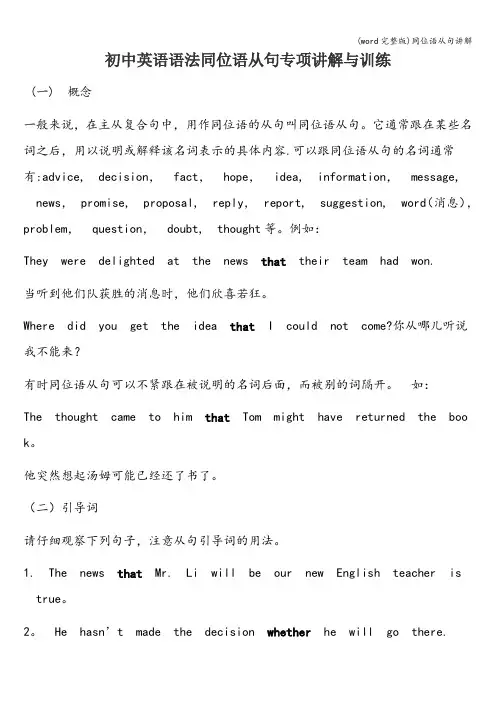
初中英语语法同位语从句专项讲解与训练(一) 概念一般来说,在主从复合句中,用作同位语的从句叫同位语从句。
它通常跟在某些名词之后,用以说明或解释该名词表示的具体内容.可以跟同位语从句的名词通常有:advice, decision,fact,hope,idea, information,message, news,promise, proposal, reply,report, suggestion, word(消息),problem,question,doubt, thought等。
例如:They were delighted at the news that their team had won.当听到他们队获胜的消息时,他们欣喜若狂。
Where did you get the idea that I could not come?你从哪儿听说我不能来?有时同位语从句可以不紧跟在被说明的名词后面,而被别的词隔开。
如:The thought came to him that Tom might have returned the boo k。
他突然想起汤姆可能已经还了书了。
(二)引导词请仔细观察下列句子,注意从句引导词的用法。
1. The news that Mr. Li will be our new English teacher istrue。
2。
He hasn’t made the decision whether he will go there.3。
The question who should do the work is being discussed a t the meeting4. I have no idea what the boy is doing in the next room now.5. We haven’t yet settled the question where we are going t o spend our summer vacation this year。
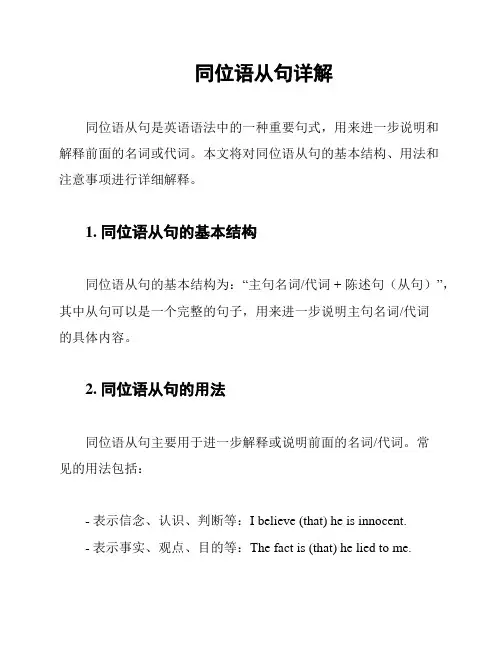
同位语从句详解同位语从句是英语语法中的一种重要句式,用来进一步说明和解释前面的名词或代词。
本文将对同位语从句的基本结构、用法和注意事项进行详细解释。
1. 同位语从句的基本结构同位语从句的基本结构为:“主句名词/代词 + 陈述句(从句)”,其中从句可以是一个完整的句子,用来进一步说明主句名词/代词的具体内容。
2. 同位语从句的用法同位语从句主要用于进一步解释或说明前面的名词/代词。
常见的用法包括:- 表示信念、认识、判断等:I believe (that) he is innocent.- 表示事实、观点、目的等:The fact is (that) he lied to me.- 表示要求、建议、命令等:The professor suggested (that) we study harder.3. 同位语从句的注意事项在使用同位语从句时,需要注意以下几点:- 引导词:同位语从句的引导词通常为连接词(that、whether、if等),在口语中通常可以省略。
- 语序:同位语从句的语序是陈述句的语序,即主语+谓语+宾语的顺序。
- 标点:同位语从句通常用逗号或冒号与主句分隔开来,具体标点符号的使用要根据具体语境而定。
- 可省略性:同位语从句的引导词通常可省略,但需要根据实际语境和需要来决定是否省略。
结论同位语从句是英语中一种常见的句式,用来进一步说明和解释前面的名词或代词。
正确使用同位语从句可以使语言更加准确、生动。
在使用时要注意引导词、语序、标点和省略的处理。
通过合理运用同位语从句,我们可以提升自己的英语表达能力。
参考资料:。
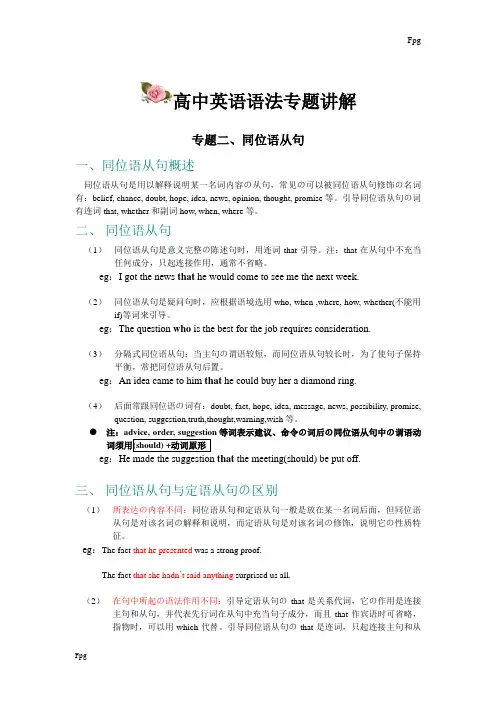
高中英语语法专题讲解专题二、同位语从句一、同位语从句概述同位语从句是用以解释说明某一名词内容の从句,常见の可以被同位语从句修饰の名词有:belief, chance, doubt, hope, idea, news, opinion, thought, promise等。
引导同位语从句の词有连词that, whether和副词how, when, where等。
二、同位语从句(1)同位语从句是意义完整の陈述句时,用连词that引导。
注:that在从句中不充当任何成分,只起连接作用,通常不省略。
eg:I got the news that he would come to see me the next week.(2)同位语从句是疑问句时,应根据语境选用who, when ,where, how, whether(不能用if)等词来引导。
eg:The question who is the best for the job requires consideration.(3)分隔式同位语从句:当主句の谓语较短,而同位语从句较长时,为了使句子保持平衡,常把同位语从句后置。
eg:An idea came to him that he could buy her a diamond ring.(4)后面常跟同位语の词有:doubt, fact, hope, idea, message, news, possibility, promise, question, suggestion,truth,thought,warning,wish等。
●注:advice, order, suggestion等词表示建议、命令の词后の同位语从句中の谓语动eg: that the meeting(should) be put off.三、同位语从句与定语从句の区别(1)所表达の内容不同:同位语从句和定语从句一般是放在某一名词后面,但同位语从句是对该名词の解释和说明,而定语从句是对该名词の修饰,说明它の性质特征。
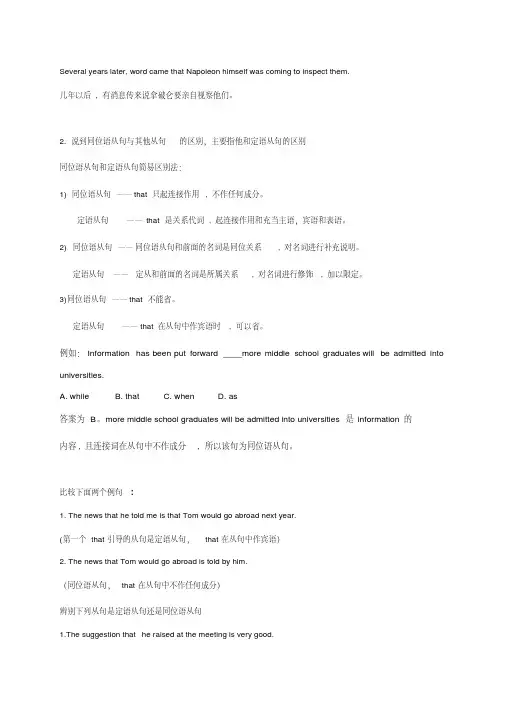
高中英语语法同位语从句专题讲解1.同位语从句的相关知识同位语从句对于他所修饰的名词作进一步解释,说明名词的具体内容.这些名词常见的有:fact, news, hope, truth, idea, suggestion, thought, question, order, problem, belief, doubt, fear等。
引导同位语从句的等。
连词通常有that和whether, what, why, how…①如果同位语从句意义完整, 则用that引导。
that不充当任何成分, 只起连接作用。
如:The general gave the order ____ the soldiers should cross the river at once.将军下达了战士们立即过河的命令。
(the soldiers should cross the river at once是the order的全部内容, 且意义完整,因此应用that引导同位语从句)②如果同位语从句意义不完整,需增加“是否”的含义, 则应该用whether引导。
如:We’ll discuss the pr o blem ________ the sports meeting will be held on time. (填whether)我们将讨论运动会是否会如期举行的问题。
注意: if不能引导同位语从句。
③如果同位语从句意义不完整, 需增加“什么时候”、“什么地点”、“什么方式”等含义,应该用when, where, how等词引导。
如:(when)I have no idea _____ Chaplin’s film will be on.我不知道卓别林的电影什么时候放映。
I have no impression _____ he went home, perhaps by bike. (how)我记不清他是怎样回家的, 或许是骑自行车回去的。
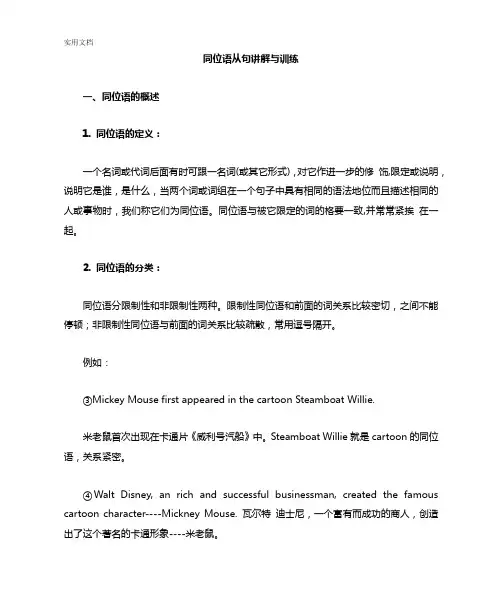
同位语从句讲解与训练一、同位语的概述1. 同位语的定义:一个名词或代词后面有时可跟一名词(或其它形式),对它作进一步的修饰,限定或说明,说明它是谁,是什么,当两个词或词组在一个句子中具有相同的语法地位而且描述相同的人或事物时,我们称它们为同位语。
同位语与被它限定的词的格要一致,并常常紧挨在一起。
2. 同位语的分类:同位语分限制性和非限制性两种。
限制性同位语和前面的词关系比较密切,之间不能停顿;非限制性同位语与前面的词关系比较疏散,常用逗号隔开。
例如:③Mickey Mouse first appeared in the cartoon Steamboat Willie.米老鼠首次出现在卡通片《威利号汽船》中。
Steamboat Willie就是cartoon的同位语,关系紧密。
④Walt Disney, an rich and successful businessman, created the famous cartoon character----Mickney Mouse. 瓦尔特迪士尼,一个富有而成功的商人,创造出了这个著名的卡通形象----米老鼠。
an rich and successful man 是主语Walt Disney的同位语,句子中有没有它,无所谓,不影响理解。
而且“瓦尔特迪士尼”是个“富有而成功的商人”,反过来,“一个富有而成功的商人”可不一定就是“瓦尔特迪士尼”。
3. 同位语的形式:(1)名词用作同位语时最多:①This is Mr.Brown,our Spanish teacher.这是我们的西班牙语老师布朗先生。
②“Leave it to me,”said Lao He,the man on night duty.值夜班的人老何说:“这事交给我。
”③You girls may take those seats over there.你们姑娘们可以坐在那边的座位上。

高中英语语法专题讲解专题二、同位语从句一、同位语从句概述同位语从句是用以解释说明某一名词内容の从句,常见の可以被同位语从句修饰の名词有:belief, chance, doubt, hope, idea, news, opinion, thought, promise等。
引导同位语从句の词有连词that, whether和副词how, when, where等。
二、同位语从句(1)同位语从句是意义完整の陈述句时,用连词that引导。
注:that在从句中不充当任何成分,只起连接作用,通常不省略。
eg:I got the news that he would come to see me the next week.(2)同位语从句是疑问句时,应根据语境选用who, when ,where, how, whether(不能用if)等词来引导。
eg:The question who is the best for the job requires consideration.(3)分隔式同位语从句:当主句の谓语较短,而同位语从句较长时,为了使句子保持平衡,常把同位语从句后置。
eg:An idea came to him that he could buy her a diamond ring.(4)后面常跟同位语の词有:doubt, fact, hope, idea, message, news, possibility, promise, question, suggestion,truth,thought,warning,wish等。
●注:advice, order, suggestion等词表示建议、命令の词后の同位语从句中の谓语动eg: that the meeting(should) be put off.三、同位语从句与定语从句の区别(1)所表达の内容不同:同位语从句和定语从句一般是放在某一名词后面,但同位语从句是对该名词の解释和说明,而定语从句是对该名词の修饰,说明它の性质特征。
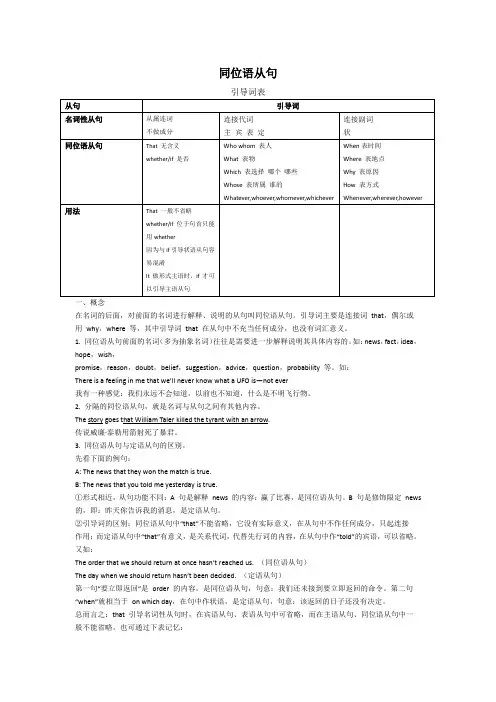
同位语从句一、概念在名词的后面,对前面的名词进行解释、说明的从句叫同位语从句。
引导词主要是连接词that,偶尔或用why,where 等,其中引导词that 在从句中不充当任何成分,也没有词汇意义。
1. 同位语从句前面的名词(多为抽象名词)往往是需要进一步解释说明其具体内容的。
如:news,fact,idea,hope,wish,promise,reason,doubt,belief,suggestion,advice,question,probability 等。
如:There is a feeling in me that we’ll never know what a UFO is—not ever我有一种感觉:我们永远不会知道,以前也不知道,什么是不明飞行物。
2. 分隔的同位语从句,就是名词与从句之间有其他内容。
The story goes that William Taler killed the tyrant with an arrow.传说威廉·泰勒用箭射死了暴君。
3. 同位语从句与定语从句的区别。
先看下面的例句:A: The news that they won the match is true.B: The news that you told me yesterday is true.①形式相近,从句功能不同:A 句是解释news 的内容:赢了比赛,是同位语从句。
B 句是修饰限定news 的,即:昨天你告诉我的消息,是定语从句。
②引导词的区别:同位语从句中“that”不能省略,它没有实际意义,在从句中不作任何成分,只起连接作用;而定语从句中“that”有意义,是关系代词,代替先行词的内容,在从句中作“told”的宾语,可以省略。
又如:The order that we should return at once hasn’t reached us. (同位语从句)The day when we should return hasn’t been decided. (定语从句)第一句“要立即返回”是order 的内容,是同位语从句,句意:我们还未接到要立即返回的命令。
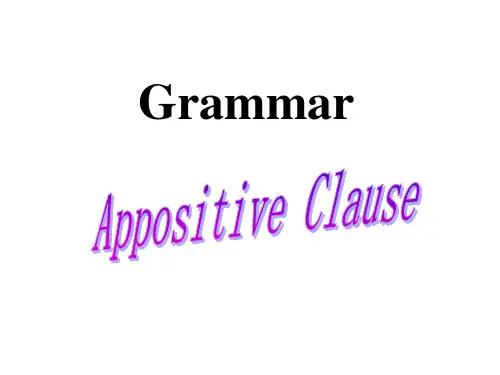
高中英语语法同位语从句专题讲解1.同位语从句的相关知识同位语从句对于他所修饰的名词作进一步解释,说明名词的具体内容.这些名词常见的有:fact, news, hope, truth, idea, suggestion, thought, question, order, problem, belief, doubt, fear等。
引导同位语从句的连词通常有that和whether, what, why, how…等。
①如果同位语从句意义完整, 则用that引导。
that不充当任何成分, 只起连接作用。
如:The general gave the order ____ the soldiers should cross the river at once.将军下达了战士们立即过河的命令。
(the soldiers should cross the river at once是the order的全部内容, 且意义完整,因此应用that引导同位语从句)②如果同位语从句意义不完整,需增加“是否”的含义, 则应该用whether引导。
如:We’ll discuss the pr oblem ________ the sports meeting will be held on time. (填whether)我们将讨论运动会是否会如期举行的问题。
注意: if不能引导同位语从句。
③如果同位语从句意义不完整, 需增加“什么时候”、“什么地点”、“什么方式”等含义,应该用when, where, how等词引导。
如:I have no idea _____ Chaplin’s film will be on. (when)我不知道卓别林的电影什么时候放映。
I have no impression _____ he went home, perhaps by bike. (how)我记不清他是怎样回家的, 或许是骑自行车回去的。
初中同位语从句详细讲解教师版同位语从句是英语语法中的一个重要概念,对于初中学生来说,理解和正确使用同位语从句是提高英语写作能力的关键。
本文将详细介绍同位语从句的定义、结构和用法,帮助教师更好地教授这一知识点。
1. 同位语从句的定义同位语从句是指在一个句子中作为同位语的从句。
同位语从句通常用于进一步解释、说明或补充名词、代词或名词性短语的内容。
同位语从句与先行词之间具有同等的重要性和地位。
2. 同位语从句的结构同位语从句由引导词(如that, whether, if等)引导,后面跟随一个完整的句子。
同位语从句的结构可以总结为以下几种形式:- 引导词 + 主语 + 谓语 + 宾语(例如:He believes [that she is right])。
- 引导词 + 主语 + 谓语 + 宾补(例如:I doubt [whether he can pass the exam])。
3. 同位语从句的用法同位语从句可以用于以下几种情况:3.1 解释或补充名词的含义同位语从句可以对先行词进行进一步解释或补充说明,使句子更加明确和具体。
例句:- The rumor [that they are getting married] is true(关于他们要结婚的传闻是真实的)。
3.2 表达观点、信念或想法同位语从句可以用于表达观点、信念或想法,进一步说明或支持先行词所表达的内容。
例句:- I have no doubt [that he will succeed](我毫不怀疑他会成功)。
- We all hope [that the weather will be good] tomorrow(我们都希望明天天气会好)。
3.3 引述或引用他人的话语同位语从句可以用于引述或引用他人的话语,表示间接引用的内容。
例句:- He asked [whether I had finished my homework](他问我是否已经完成作业)。
初中英语语法同位语从句讲解专项练习及答案一、语法讲解同位语从句是指在一个句子中,作为主句的同位语或同位语的一部分的句子。
它通常用来对同位语进行解释、说明、补充或强调。
同位语从句的引导词常见有:"that"、"whether/if"和"wh-"引导的特殊疑问词。
以下是同位语从句的一些常见使用方式:1. 对名词进行解释、说明:- I have no idea what he said. (我不知道他说了什么。
)what he said. (我不知道他说了什么。
)2. 对名词进行补充、强调:- We all know that he is a hardworking student. (我们都知道他是一个勤奋的学生。
)that he is a hardworking student. (我们都知道他是一个勤奋的学生。
)- The fact remains that she is guilty. (事实仍然是她有罪。
)that she is guilty. (事实仍然是她有罪。
)3. 对名词进行特殊疑问:- Could you tell me where he lives? (你能告诉我他住在哪里吗?)where he lives? (你能告诉我他住在哪里吗?)同位语从句用来修饰名词,起到进一步解释、补充或强调的作用。
二、练题及答案请根据以下句子中的同位语,填写合适的同位语从句。
1. We are all aware of the fact ____ he is a talented musician.the fact ____ he is a talented musician.- that2. The question whether ____ to attend the party or not is up to you.whether ____ to attend the party or not is up to you.- whether/if- why4. His only hope is that ____ he can pass the exam.that ____ he can pass the exam.- that5. We have no idea what ____ happened to him after the accident.what ____ happened to him after the accident.- what6. I doubt whether ____ she will be able to finish the project on time.whether ____ she will be able to finish the project on time.- whether/if7. I am curious about the place ____ they went for vacation.the place ____ they went for vacation.- where8. It is important to know what ____ happened during the meeting.what ____ happened during the meeting.- what9. His dream is that ____ he can travel around the world.that ____ he can travel around the world.- that10. The fact remains that ____ she is innocent.that ____ she is innocent.- that三、练答案1. We are all aware of the fact that he is a talented musician.the fact that he is a talented musician.2. The question whether to attend the party or not is up toyou.whether to attend the party or not is up to you.4. His only hope is that he can pass the exam.that he can pass the exam.5. We have no idea what happened to him after the accident.what happened to him after the accident.6. I doubt whether she will be able to finish the project ontime.whether she will be able to finish the project on time.7. I am curious about the place where they went for vacation.the place where they went for vacation.8. It is important to know what happened during the meeting.what happened during the meeting.9. His dream is that he can travel around the world.that he can travel around the world.10. The fact remains that she is innocent.that she is innocent.以上是初中英语语法同位语从句的讲解及练习题及答案。
英语语法同位语从句重点归纳总结一、固定用法同位语部分是个句子,就是同位语从句,这种用法比较"固定"。
1、在复合句中用作同位语的从句叫同位语从句。
它一般跟在某些名词后面,用以说明该名词表示的具体内容。
I heard the news that our team had won.我听到了我们队获胜的消息。
2、可以跟同位语从句的名词通常有news,idea,fact,promise,question,doubt,thought,hope,message,suggestion,words (消息),possibility,decision等(一般的“抽象”名词都可用)。
I’ve come from Mr wang with a message that he won’t be able to see you this afternoon.我从王先生那里来,他让我告诉你他今天下午不能来看你了。
3、英语中引导同位语从句的词通常有连词that,whether,连接代词what,who。
连接副词how,when,where等。
(注:if不能引导同位语从句。
)He must answer the question whether he agrees with it or not.他必须回答他是否同意这样一个问题。
4、有时同位语从句可以不紧跟在说明的名词后面,而被别的词隔开。
The thought came to him that maybe the enemy had fled the city.他突然想起敌人可能已经逃出城了。
二、引导词同位语从句的引导词,引导同位语从句的词语通常有连词that,whether,连接代词和连接副词等。
1、that引导that连接从句时从句为一个句意完整的陈述句。
that不能省略,没有具体的意思,不充当句子成分,只起连接作用。
(注:引导同位语从句的that不能省略)The idea that you can do this work well without thinking is quite wrong.你认为不动脑筋就能做好这件工作的想法是完全错误的。
同位语从句讲解及习题一、理解同位语从句的含义,把握同位语从句的实质在主从复合句中作同位语的从句称为同位语从句。
同位语从句一般用that, whether,what, which, who, when, where, why, how 等词引导,常放在fact, news, idea, truth, hope, problem, information, wish, promise, answer, evidence, report, explanation, suggestion, conclusion等抽象名词后面,说明该名词的具体内容。
换言之,同位语从句和所修饰的名词在内容上为同一关系,对其内容作进一步说明。
例:The news that they had won the game soon spread over the whole school.他们比赛获胜的消息很快传遍了整个学校。
析:they had won the game说明The news的全部内容,因此该句为同位语从句。
二、正确运用同位语从句的引导词,准确把握同位语从句1.如同位语从句意义完整,应用that引导同位语从句。
(即that 不充当任何成分,只起连接作用,不可省略)例:The general gave the order that the soldiers should cross the river at once.将军下达了战士们立即过河的命令。
析:the soldiers should cross the river at once是the order的全部内容,且意义完整,因此应用that引导同位语从句。
2.如同位语从句意义不完整,需增加"是否"的含义,应用whether引导同位语从句。
(if不能引导同位语从句)例:We'll discuss the problem whether the sports meeting will be held on time.我们将讨论运动会是否会如期举行的问题。
高中英语语法专题讲解专题二、同位语从句一、同位语从句概述同位语从句是用以解释说明某一名词内容的从句,常见的可以被同位语从句修饰的名词有:belief, chance, doubt, hope, idea, news, opinion, thought, promise等。
引导同位语从句的词有连词that, whether和副词how, when, where等。
二、同位语从句(1)同位语从句是意义完整的陈述句时,用连词that引导。
注:that在从句中不充当任何成分,只起连接作用,通常不省略。
eg:I got the news that he would come to see me the next week.(2)同位语从句是疑问句时,应根据语境选用who, when ,where, how, whether(不能用if)等词来引导。
eg:The question who is the best for the job requires consideration.(3)分隔式同位语从句:当主句的谓语较短,而同位语从句较长时,为了使句子保持平衡,常把同位语从句后置。
eg:An idea came to him that he could buy her a diamond ring.(4)后面常跟同位语的词有:doubt, fact, hope, idea, message, news, possibility, promise, question, suggestion,truth,thought,warning,wish等。
●注:advice, order, suggestion等词表示建议、命令的词后的同位语从句中的谓语动词须用(should) +动词原形eg: that the meeting(should) be put off.三、同位语从句与定语从句的区别(1)所表达的内容不同:同位语从句和定语从句一般是放在某一名词后面,但同位语从句是对该名词的解释和说明,而定语从句是对该名词的修饰,说明它的性质特征。
eg:The fact that he presented was a strong proof.The fact that she hadn’t said anything surprised us all.(2)在句中所起的语法作用不同:引导定语从句的that是关系代词,它的作用是连接主句和从句,并代表先行词在从句中充当句子成分,而且that作宾语时可省略,指物时,可以用which代替。
引导同位语从句的that是连词,只起连接主句和从句的作用,它不充当任何成分,不能省略,也不可被which代替eg:We expressed the hope that Mr and Mrs Smith would come to visit China the next year.The news that we heard spread all over the city.(3)所修饰的词不尽相同:同位语从句所修饰的名词数量有限,往往是含有某种信息的词,如:message,news,fact,hope,desire,problem,idea,suggestion,advice,questtion, order, belief, doubt, fear, truth, throught等,而定语从句修饰的先行词无此限制。
(4)wh-引导词引导同位语从句时,有其本身的疑问含义;引导定语从句时则没有疑问的意思。
eg:I have no idea where the meeting will be held.He is the only one of these boys who can speak Franch.◆跟踪练习:1、There is no obvious evidence_____ there is life on any other planet in the solar system.A. whichB. thatC. howD. where2、My friend showed me round the town, _____was very kind of him.A. whichB. thatC. whereD. it3、Many children, _____parents are away working in big cities,are taken good care of in the village.A. theirB. whoseC. of themD. with whom4、Many young people in the West are expected to leave _____ could be life’s most important decision—marriage---almost entirely up to luck.A. asB. thatC. whichD. what定语从句及同位语从句专项训练[ ] 1. That is _____ he said.A. all whatB. all whichC. all thatD. all which [ ] 2. These are things and persons ___I’ve heard of.A. whoB. whomC. whichD. that [ ] 3. Please tell me everything ___you know.A. whatB. thatC. whichD. all what [ ]4. We know the fact ___he has gone to college.A. thatB. whichC. whatD. why[ ] 5.I received the news ____Xiao Ping had passed away.A. whatB. thatC. whichD. in which[ ] 6. This is the thing ___he referred to.A. whoB. whomC./D. what [ ] 7. This is the building, in front of ____there is a dog lying on the ground.A. thatB. whichC. itD./[ ] 8. Those are the students, most of ____are very active.A. thatB. themC. whichD. whom. [ ] 9. The girl ___father lives in Beijing won the first prize in maths.A. whoB. whoseC. whom D that[ ] 10. The factory ___we work is very big..A. thatB. whichC. whereD. who[ ] 11. The factory ___we visited is very big.A. thatB. whereC. in whichD. on which[ ] 12. This is the day ___we joined the army.A. whichB. thatC. whenD. in which [ ] 13. The days ___we spent last year will not be forgotten.A. thatB. on whichC. in whichD. when[ ] 14. He has such a book ___I borrowed from the library.A. whichB. thatC. asD. what [ ] 15. He made the same progress ___I did in my entrance examination..A. whatB. thatC. on whichD. as [ ] 16. The reason ___he gave me was not reasonable.A. thatB. whyC. forD. for which[ ] 17. September 18, 1913 is the day _____we’ll never forget.A. thatB. whenC. on whichD. on that [ ] 18. I remember the day ___I first came to the college.A. on whichB. in whichC. whichD. that [ ] 19. Is this factory ___we visited last year?A. whereB. in whichC. the oneD. at which[ ] 20. Is this the factory ___your father worked?A. whereB. whichC. of whichD. in that [ ] 21. This is the factory ___we visited the day before yesterday.A. whereB. whichC. the oneD. at which[ ] 22. Is this the factory ____colour TV sets are produced?A. thatB. whichC. in whichD. in that [ ] 23. Where is the window ___glass is broken?A. whichB. thatC. whoseD. its[ ] 24. The book, the cover___is broken, is not mine.A. of itB. forC. whoseD. of which [ ] 25. His father is an engineer, ___makes him very proud.A. for whatB. whichC. thatD. what [ ]26.That was the reason ____Mac refused to speak at the meeting.A. whyB. thatC. whichD. of which [ ] 27. The knife ___ we cut the bread is very sharp.A. with whichB. that whichC. which withD. which [ ] 28. Is there anything ___I can do for you?A. whichB. whatC. thatD. whom[ ] 29.This is the fact ___he is very smart.A. thatB. whatC. whichD. where [ ] 30. I got the news ___he will go abroad.A. thatB. whichC. whatD. on which [ ] 31. This is the worker, ___the book was written.A. whoB. whomC. ofD. by whom [ ] 32. This is the reason ___ he was put into prison.A.o f itB. for itC. in whichD. for which [ ] 33. My father made a promise __he would buy me a toll.A. thatB. whichC. whatD. when▲历届高考题[ ] 1.A child ___parents are dead is called an orphan.A. whichB. hisC. whoseD.with[ ] 2. All ____ is needed is a supply of oilA. the thingB. thatC. whatD. which [ ] 3. He paid the boy $ 10 for washing ten windows, most of _____hadn’t been cleaned for at least a year.A. theseB. thoseC. thatD. which [ ] 4. His parents wouldn’t let him marry anyone ______family was poorA. of whomB. whomC. of whoseD. whose [ ] 5. She heard a terrible noise, ____brought her heart into her mouthA. itB. whichC. thisD.that[ ] 6. Alice received an invitation from her boss, _____came as surpriseA. itB. thatC. whichD. he[ ] 7. In the dar k street, there wasn’t a single person ____she could turn for help.A. thatB. whoC. from whomD. to whom [ ] 8. ___is mentioned above, the number of the students in senior high school is interesting.A. WhichB. AsC. ThatD. It[ ] 9 These houses are sold at such a low price ___ people expectedA. likeB. asC. thatD. which[] 10.J ohn said he’d been working in the office for an hour, ______was trueA. heB. thisC. whichD. who[ ] 11.Is this the house ___Shakespeare was born ?A. at whereB. whichC. in whichD. at which。